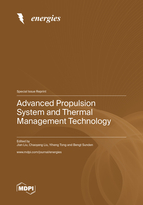Advanced Propulsion System and Thermal Management Technology
A special issue of Energies (ISSN 1996-1073). This special issue belongs to the section "J: Thermal Management".
Deadline for manuscript submissions: closed (31 December 2022) | Viewed by 12893
Special Issue Editors
Interests: gas turbine; convective heat transfer; film cooling; transpiration cooling; scramjet; powder fuel; porous media; combustion; PIV; experimental heat transfer
Special Issues, Collections and Topics in MDPI journals
Interests: supersonic flow and combustion
Special Issues, Collections and Topics in MDPI journals
Interests: combustion instability and spray dynamics related to gas turbine and liquid rocket engines
Special Issues, Collections and Topics in MDPI journals
Interests: PEMFC; SOFC; batteries; hydrogen production and storage; renewable energy
Special Issues, Collections and Topics in MDPI journals
Special Issue Information
Dear Colleagues,
Propulsion systems still receive much research attention, especially aircraft engines, rocket engines and scramjets, etc. Some new propulsion systems are proposed that combine two basic propulsion systems, such as RBCC and TBCC, as well as new types of propulsion systems, such as combined space–air–ocean systems and highly integrated power systems, which can allow aircraft to fly safely from areas over land to those over the ocean. Propulsion systems are developed with the features of a wide speed range and long endurance, both for civil aircraft and military applications. Studies of propulsion systems mainly address their overall design, combustion, aerodynamics, internal flow and heat transfer, etc. High efficiency is pursued not only by optimized design but also via the development of suitable materials as well as the usage of powdered fuel.
Along with the development of high-efficiency propulsion systems, thermal management technology is also developed to address the increased heat from external aerodynamic heating and internal combustion heat at high speeds. This thermal management technology can transfer excessive heat to other low-temperature regions or provide thermal protection for structures via blade cooling in gas turbines and regenerative cooling in rocket engines. The thermal protection of engines is highly efficient due to the enhancement of convective heat transfer, such as the usage of superficial fluids, nanofluids, or newly designed roughened surfaces. Additionally, some heat transfer enhancement methods in heat exchangers, batteries and fuel cells are implemented in propulsion systems.
This Special Issue focuses on bringing together innovative developments in the fields of advanced propulsion systems and thermal management technology. Potential topics include, but are not limited to:
- Propulsion system design;
- Heat transfer enhancement;
- Turbulent combustion;
- Supercritical fluid;
- Regenerative cooling;
- Flow control;
- Laser-based combustion diagnostics;
- Spray dynamics;
- Nanofluids;
- Blade cooling;
- Film cooling;
- Transpiration cooling;
- Multiphase flow;
- Heat transfer in propulsion system;
- Aerodynamics;
- Combustion instability;
- Powder fuel;
- Spray dynamics;
- Convective heat transfer;
- Supersonic vehicles;
- Thermal management in other fields.
Dr. Jian Liu
Dr. Chaoyang Liu
Dr. Yiheng Tong
Prof. Dr. Bengt Sunden
Guest Editors
Manuscript Submission Information
Manuscripts should be submitted online at www.mdpi.com by registering and logging in to this website. Once you are registered, click here to go to the submission form. Manuscripts can be submitted until the deadline. All submissions that pass pre-check are peer-reviewed. Accepted papers will be published continuously in the journal (as soon as accepted) and will be listed together on the special issue website. Research articles, review articles as well as short communications are invited. For planned papers, a title and short abstract (about 100 words) can be sent to the Editorial Office for announcement on this website.
Submitted manuscripts should not have been published previously, nor be under consideration for publication elsewhere (except conference proceedings papers). All manuscripts are thoroughly refereed through a single-blind peer-review process. A guide for authors and other relevant information for submission of manuscripts is available on the Instructions for Authors page. Energies is an international peer-reviewed open access semimonthly journal published by MDPI.
Please visit the Instructions for Authors page before submitting a manuscript. The Article Processing Charge (APC) for publication in this open access journal is 2600 CHF (Swiss Francs). Submitted papers should be well formatted and use good English. Authors may use MDPI's English editing service prior to publication or during author revisions.
Keywords
- propulsion system
- supersonic vehicles
- heat transfer
- combustion
- turbulence flow
- thermal protection
- atomization
- thermal acoustics
- spray self-pulsation








